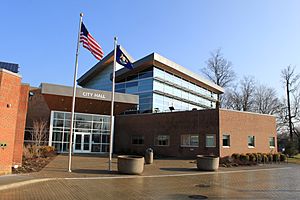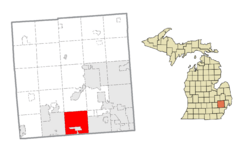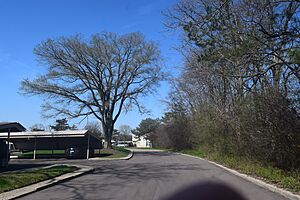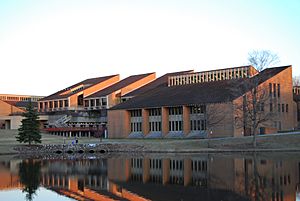Farmington Hills, Michigan facts for kids
Quick facts for kids
Farmington Hills, Michigan
|
|||
|---|---|---|---|
| City of Farmington Hills | |||

Farmington Hills City Hall in 2012
|
|||
|
|||

Location within Oakland County
|
|||
| Country | United States | ||
| State | Michigan | ||
| County | Oakland | ||
| Settled | 1824 | ||
| Organized | 1827 (township) | ||
| Incorporated | 1973 (city) | ||
| Government | |||
| • Type | Council–manager | ||
| Area | |||
| • City | 33.30 sq mi (86.24 km2) | ||
| • Land | 33.27 sq mi (86.16 km2) | ||
| • Water | 0.03 sq mi (0.07 km2) | ||
| Elevation | 860 ft (262 m) | ||
| Population
(2020)
|
|||
| • City | 83,986 | ||
| • Density | 2,524.53/sq mi (974.72/km2) | ||
| • Metro | 4,285,832 (Metro Detroit) | ||
| Time zone | UTC-5 (EST) | ||
| • Summer (DST) | UTC-4 (EDT) | ||
| ZIP code(s) |
48331, 48334–48336
|
||
| Area code(s) | 248 | ||
| FIPS code | 26-27440 | ||
| GNIS feature ID | 1616988 | ||
Farmington Hills is a city in Oakland County in the U.S. state of Michigan. A northwestern suburb of Detroit, Farmington Hills is located roughly 22 miles (35.4 km) from downtown Detroit. As of the 2020 census, the city's population was 83,986, making it the second-largest community in Oakland County.
Farmington Hills consistently ranks as one of the safest cities in the United States, as well as in the state of Michigan. The area ranked as the 30th safest city in the U.S. in 2010 and as the 2nd safest city in Michigan in 2020. Farmington Hills also ranks as the 36th highest-income place in the United States with a population of 50,000 or more and ranked as 14th America's best cities to live by 24/7 Wall St. in 2016.
Although the two cities have separate services and addresses, Farmington and Farmington Hills are often thought of as the same community. These two cities combined were part of Farmington Township in the time of the Northwest Territory. Features of the community include a recently renovated downtown, boutiques, a vintage cinema, numerous restaurants, exotic car dealerships, art galleries, and public parks including Heritage Park. There are several historical sites including the Longacre House and the Governor Warner Mansion. Both cities are served by Farmington Public Schools and the Farmington Community Library.
Farmington Hills is the home of the Holocaust Memorial Center, the only Holocaust memorial in the State of Michigan. The center's mission is to educate the public about the tragedy and evils of the Holocaust. The Holocaust Memorial Center was originally located in neighboring West Bloomfield Township, but has since expanded and moved to its current facility.
Contents
Geography
According to the United States Census Bureau, the city has a total area of 33.31 square miles (86.27 km2), of which 33.28 square miles (86.19 km2) is land and 0.03 square miles (0.08 km2) is water. Farmington Hills is bordered by West Bloomfield to the north, Franklin and Southfield to the east, Livonia to the south, and Novi to the west.
History
The first white settler in what became Farmington Township was a Quaker from Farmington, New York, named Arthur Power. He purchased land in 1823 and returned in 1824 with a group of families and associates to clear the land. The settlement became known as Quakertown. A post office was established in February 1826 with the name of Farmington. The original post office is still standing today, and is a designated historical site. The township of Farmington was organized in 1827, and the settlement was incorporated as the village of Farmington in the winter of 1866–67. A fire on October 9, 1872, destroyed many buildings in the village center. Farmington was incorporated as a city in 1926.
A small settlement was also developed in Clarenceville, in the extreme southeast corner of the township on the boundary with Livonia in Wayne County. Stephen Jennings built a tavern and a general store to accommodate travelers on the plank road between Detroit and Howell. The name remains in the Clarenceville School District. Even though the school buildings for Clarenceville are in Livonia in Wayne County, the school district serves a portion of Farmington Hills.
In 1839, a post office named East Farmington was opened, but it closed in 1842.
In 1847, a post office named North Farmington was established a mile south of the township line as Wolcott's Corners. After the death of postmaster Chauncey D. Walcott in 1865, the office moved to the township line in the northeast quarter of section 4 (near the intersection of 14 Mile Road and Farmington Road). The post office functioned until September 1902.
Before the remainder of Farmington Township was incorporated as the city of Farmington Hills, there were two other incorporated entities within its boundaries. The first began as a subdivision named Quaker Valley Farms that was incorporated as the village of Quakertown in 1959. The other was Wood Creek Farms, developed in 1937 as a subdivision by George Wellington of Franklin, who named it after a New England estate. It was incorporated as a village in 1957. The villages, together with the remainder of Farmington Township, were incorporated into the City of Farmington Hills in 1973. The City grew rapidly throughout the mid-20th century.
Economy
Farmington Hills is home to the headquarters of numerous major companies, including Gale, Mango Languages, 5-Hour Energy, and The Sharper Image, as well as the United States headquarters of Bosch, Mercedes-Benz Financial Services, and TD Auto Finance. The city was also previously home to the headquarters of Compuware, White Motor Company, A&W Restaurants, and Michigan National Bank.
Nissan's North American technical center is located in Farmington Hills. The Nissan technical center handled project engineering of vehicle bodies used in North America and Latin America. It also has a small laboratory, where as of 2012, research is being conducted with hydrogen fuel cells. The company planned to add electrical battery and recharging of electrical vehicle research to the laboratory. As of January 2012 the technical center had 800 full-time employees. At that time Nissan planned to hire 150 more engineers to work in the technical center. The technical center opened in November 1991 at a cost of $80 million. In 2005, Nissan added a $14 million design studio at their Farmington Hills campus, and the Nissan AZEAL was the first car to be designed there.
Hitachi Automotive Systems Americas, Inc. maintains an office in Farmington Hills, as does Panasonic Automotive Systems. Lordstown Motors operates a research and development center in Farmington Hills.
According to the city's 2019 Comprehensive Annual Financial Report, the top local employers are:
| # | Employer | # of Employees |
|---|---|---|
| 1 | Beaumont Hospital | 2,500 |
| 2 | Robert Bosch Corporation | 1,400 |
| 3 | Nissan Technical Center North America | 1,200 |
| 4 | Hitachi | 1,200 |
| 5 | Farmington Public Schools | 1,100 |
| 6 | TRW Automotive Electronics | 650 |
| 7 | Mercedes-Benz Financial Services | 650 |
| 8 | Concentrix | 550 |
| 9 | Gale | 500 |
| 10 | Mahle | 500 |
Demographics
| Historical population | |||
|---|---|---|---|
| Census | Pop. | %± | |
| 1980 | 58,056 | — | |
| 1990 | 74,611 | 28.5% | |
| 2000 | 82,111 | 10.1% | |
| 2010 | 79,740 | −2.9% | |
| 2020 | 83,986 | 5.3% | |
| 2018 Estimate | |||
According to a 2015 estimate, the median income for a household in the city was $93,274, and the median income for a family was $198,136. Males had a median income of $61,757 versus $39,540 for females. The per capita income for the city was $36,134. Farmington Hills is well known for its luxury estates, its rolling hills, and is also listed on Forbes as one of the most prosperous suburbs in the US, with a household net worth of $725,120. About 2.4% of families and 4.1% of the population were below the poverty line, including 3.2% of those under age 18 and 7.6% of those age 65 or over.
2020 census
As of the census of 2020, there were 83,986 people residing in the city, and 33,972 households. The population density was 2,396.0 inhabitants per square mile (925.1/km2). The racial makeup (including Hispanics in the racial categories) of the city was 62.7% White, 19.9% Black or African American, 0.4% Native American, 14.1% Asian, and 2.4% from two or more races. Hispanic or Latino of any race were 2.3% of the population.
| Race / Ethnicity (NH = Non-Hispanic) | Pop 2000 | Pop 2010 | Pop 2020 | % 2000 | % 2010 | % 2020 |
|---|---|---|---|---|---|---|
| White alone (NH) | 67,250 | 54,466 | 49,603 | 81.90% | 68.30% | 59.06% |
| Black or African American alone (NH) | 5,681 | 13,768 | 15,268 | 6.92% | 17.27% | 18.18% |
| Native American or Alaska Native alone (NH) | 132 | 139 | 110 | 0.16% | 0.17% | 0.13% |
| Asian alone (NH) | 6,184 | 8,063 | 12,867 | 7.53% | 10.11% | 15.32% |
| Pacific Islander alone (NH) | 14 | 12 | 20 | 0.02% | 0.02% | 0.02% |
| Other race alone (NH) | 145 | 144 | 374 | 0.18% | 0.18% | 0.45% |
| Mixed race or Multiracial (NH) | 1,494 | 1,604 | 3,104 | 1.82% | 2.01% | 3.70% |
| Hispanic or Latino (any race) | 1,211 | 1,544 | 2,640 | 1.47% | 1.94% | 3.14% |
| Total | 82,111 | 79,740 | 83,986 | 100.00% | 100.00% | 100.00% |
2010 census
As of the census of 2010, there were 79,740 people, 33,559 households, and 21,412 families residing in the city. The population density was 2,396.0 inhabitants per square mile (925.1/km2). There were 36,178 housing units at an average density of 1,087.1 per square mile (419.7/km2). The racial makeup of the city was 69.7% White, 17.4% African American, 0.2% Native American, 10.1% Asian, 0.4% from other races, and 2.2% from two or more races. Hispanic or Latino of any race were 1.9% of the population.
There were 33,559 households, of which 29.1% had children under the age of 18 living with them, 50.7% were married couples living together, 9.9% had a female householder with no husband present, 3.2% had a male householder with no wife present, and 36.2% were non-families. 31.5% of all households were made up of individuals, and 12% had someone living alone who was 65 years of age or older. The average household size was 2.36 and the average family size was 3.00.
The median age in the city was 42.1 years. 21.5% of residents were under the age of 18; 7.1% were between the ages of 18 and 24; 25.2% were from 25 to 44; 30.2% were from 45 to 64; and 15.9% were 65 years of age or older. The gender makeup of the city was 47.1% male and 52.9% female.
In April 2013, Farmington Hills had the fourth largest Japanese national population in the state of Michigan, at 589.
Education
Primary and secondary schools
Almost all of Farmington Hills is located in the Farmington Public Schools district. The district includes eight elementary schools, three middle schools, and one K-8 lottery school, of which all but one are located in Farmington Hills. North Farmington High School, a large traditional high school, and Farmington Central High School, a smaller alternative high school, are located in Farmington Hills, and Farmington High School in neighboring Farmington also serves portions of Farmington Hills. Harrison High School also operated in the city from 1970 until its closure in 2019, after which it was repurposed as a community center, named The Hawk.
Small portions of the city are within the Clarenceville and Walled Lake Consolidated school districts. The city is also home to Oakland Early College, an early college high school administered by the West Bloomfield School District.
The area includes several private schools, including two parochial Catholic schools, Our Lady of Sorrows and St. Fabian, run by the Archdiocese of Detroit. St. Fabian is in Farmington Hills, and Our Lady of Sorrows School is in Farmington. Farmington Hills also includes an all-girls Catholic high school, Mercy High School, one Lutheran school, Concordia Lutheran School/St. Paul's Lutheran Preschool, and Hillel Day School, a non-denominational Jewish day school.
Colleges and universities
The Orchard Ridge campus of Oakland Community College is located in Farmington Hills, as is the Michigan School of Psychology.
Farmington Hills was also the location for the ficticious University of Farmington, created by the U.S. Immigration and Customs Enforcement's Homeland Security Investigations (HSI) as part of a sting operation.
Transportation
The major thoroughfares in the city are M-5, Orchard Lake Road, 12 Mile Road, 8 Mile Road, Northwestern Highway, I-696, and I-275. The city contains several freeway interchanges connecting local roads to the two interstates. Public transit services are provided by SMART.
Notable people
Notable current and former residents include:
- Jena Irene Asciutto, singer, American Idol runner-up
- Steve Ballmer, businessman, former CEO of Microsoft, owner of the NBA's Los Angeles Clippers
- Elizabeth Berkley, actress
- Manoj Bhargava, founder and CEO, 5-hour Energy
- Pam Dawber, actress
- Alex DeBrincat, NHL hockey player for the Detroit Red Wings
- Colin Egglesfield, actor
- Sean Forbes Award Winning Deaf Musician
- Donald Foss (born 1945), billionaire founder of subprime car finance company Credit Acceptance
- Cam Fowler, NHL hockey player for the Anaheim Ducks
- Devin Funchess, wide receiver for the NFL's Detroit Lions
- Tatiana Gutsu, two-time Olympic champion gymnast
- Kirsten Haglund, winner of Miss Michigan (2007) and Miss America (2008)
- Arthur Hanlon, Latin musician
- Al Jean, writer/producer, The Simpsons
- Bill Joy, co-founder of Sun Microsystems
- Meg Mallon, professional golfer in Hall of Fame
- Jason Miller, rabbi and entrepreneur
- Jaime Ray Newman, actress
- Eren Ozker, puppeteer, Muppeteer
- Austin Price (born 1995), basketball player in the Israeli Premier Basketball League
- Cayden Primeau, NHL hockey goaltender for the Montreal Canadiens
- Neal Rubin, columnist for The Detroit News
- Barry Sanders, Hall of Fame running back for the Detroit Lions; resident
- Drew Stanton, retired NFL quarterback who played for the Michigan State Spartans football team
- Tally Hall, indie rock band based in Ann Arbor
- Fred Toucher, Boston radio DJ for 98.5 The Sports Hub
- James Wolk, actor
- Brian S. Eifler, 11th Airborne Division commanding general
- Cory DeVante Williams, YouTuber
- Megan Keller, current forward with PWHL Boston with two Olympic Appearances.
See also
 In Spanish: Farmington Hills para niños
In Spanish: Farmington Hills para niños






